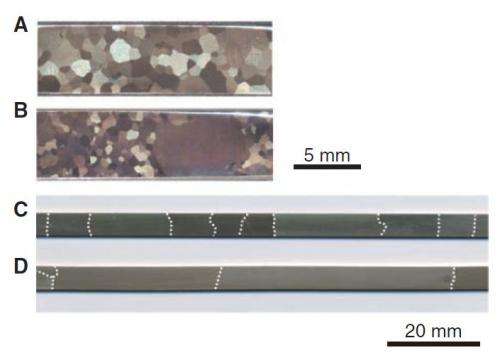September 27, 2013 report
Researchers devise a means to obtain abnormal grain growth in metal using cyclic heat treatment

(Phys.org) —A team of researchers from Tohoku University and Kyoto University in Japan has found a way to cause abnormal grain growth in metal crystals using cyclic heat treatment. In their paper published in the journal Science, the team describes how they came up with the approach, how well it works and how it might be used in future applications.
In the never ending struggle to develop more kinds of metals that are suitable for a larger variety of purposes, scientists have studied the very nature of metals to better learn how it is they perform the way they do under different circumstances. Creating them one way, for example, results in a highly bendable but relatively weak metal—creating them another way can produce just the opposite. As part of the research involving metals, scientists have discovered that metals hold their shape in ways that are very similar to ceramics—it's all based on crystal formation and how the crystals bind to one another.
With metals, crystals bond together where they interface, known in the trade as the Grain Boundary (GB). Treating the metal can cause changes to the boundary which in turn impacts the properties of the finished product. Unfortunately, working with metals is still oftentimes more art than science—how grain boundaries form and impact interactions between crystals is still not wholly understood. What is known is that applying heat can cause the GB to stretch, causing longer grain formation—the result is a metal that can better endure multiple bends. Unfortunately, adding heat can only go so far, which is why researchers continue to look for ways to change the GB to add more desirable properties to metals.
In this new effort, the researchers tried a cycling method—applying heat, allowing for cooling, then reapplying for as many times as appears to be beneficial. They applied the heat cycling to a copper based shape-memory alloy (metal that has been developed to revert automatically back to its original shape under certain specified conditions). Doing so they found, resulted in what metallurgists call Abnormal Grain Growth (AGG) which is where some of the crystals grow to different sizes than their neighbors. When it occurs in beneficial ways, as it did in the researchers experiment, it can result in the development of much longer grains, which translate to more robust metals.
The researchers believe their technique might be used to create alloys with longer service lives and also may serve as the jumping off point for a whole new line of research, dedicated to better understanding the relationship between grain size as it relates to GB and the way it is changed with heat.
More information: Abnormal Grain Growth Induced by Cyclic Heat Treatment, Science 27 September 2013: Vol. 341 no. 6153 pp. 1500-1502 DOI: 10.1126/science.1238017
ABSTRACT
In polycrystalline materials, grain growth occurs at elevated temperatures to reduce the total area of grain boundaries with high energy. The grain growth rate usually slows down with annealing time, making it hard to obtain grains larger than a millimeter in size. We report a crystal growth method that employs only a cyclic heat treatment to obtain a single crystal of more than several centimeters in a copper-based shape-memory alloy. This abnormal grain growth phenomenon results from the formation of a subgrain structure introduced through phase transformation. These findings provide a method of fabricating a single-crystal or large-grain structure important for shape-memory properties, magnetic properties, and creep properties, among others.
Journal information: Science
© 2013 Phys.org





















